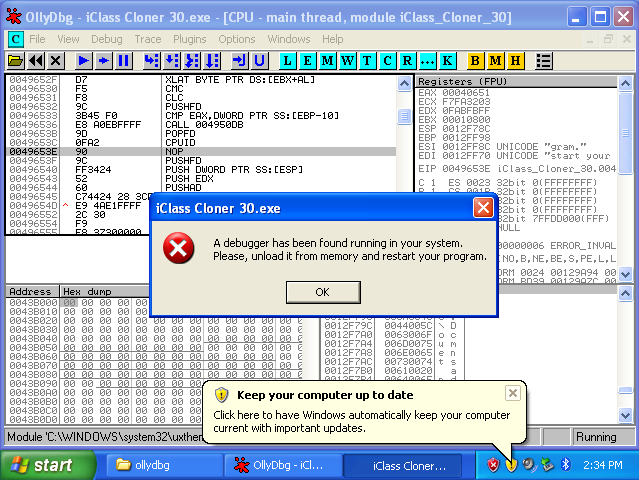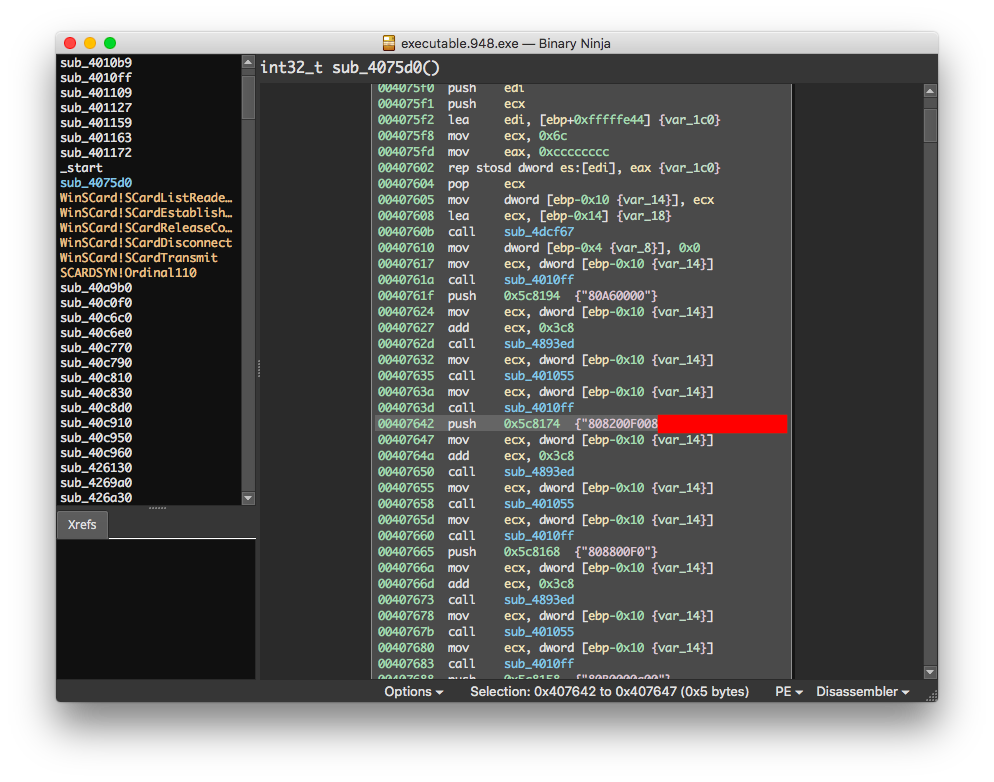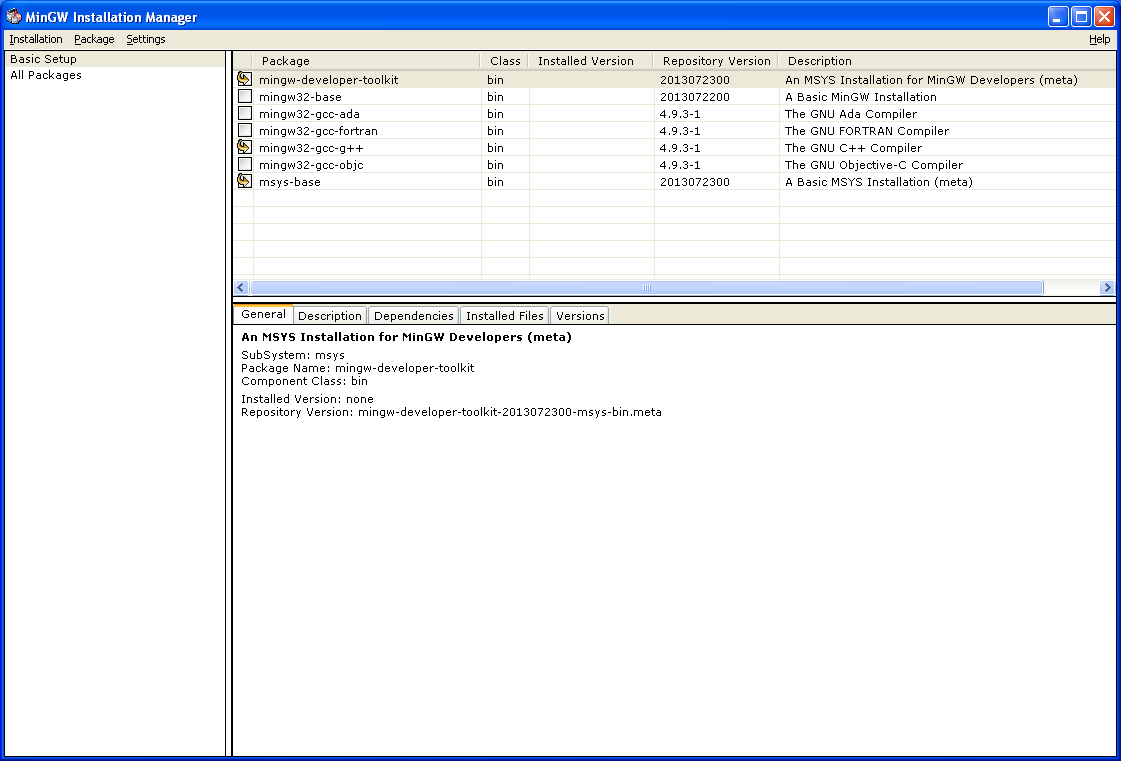Reverse Engineering HID iClass Master Keys
The HID iClass line of proximity cards and readers is a widely deployed RFID system that's been poked full of holes by security researchers. The system boasts a higher level of security through encryption and mutual authentication.
But neither of these defenses mean much when the master authentication key used by every standard iClass reader is retrievable by a moderately technical individual.
The authentication key is highly sensitive as it allows one to read decrypted card content and also overwrite card content. This effectively means that an attacker with possession of the authentication key is capable of cloning HID iClass cards and changing configuration settings on the physical reader itself.
Getting the Keys
The original approach for gaining the HID master key was disclosed in a paper entitled Heart of Darkness - exploring the uncharted
backwaters of HID iCLASS™ security. This method takes advantage of a vulnerability in a specific line of readers released by HID which expose 6 debug pins on the rear of the reader. The Heart of Darkness approach entails leveraging those debug pins to modify the on-board firmware of two vulnerable readers. By modifying the firmwares, the readers each dump one half of the complete firmware image. The two halves can be stitched together to create a full firmware image which can be used to re-flash the two sacrificial readers.
The most commonly exploited reader is the HID RW300 Rev A, but you can use an RW300, RW400, RWK400, R30, R40, or RK40. The only caveat is that it must be Revision A. Revision B or C will not work. These are fairly hard to come by, but if you monitor Ebay or keep a watchful eye on Google, you could get lucky.

If you want to replicate the Heart of Darkness method, you will be looking for two of these model numbers:
- 6110A (R30)
- 6111A (RW300)
- 6120A (R40)
- 6121A (RW400)
- 6130A (RK40)
- 6131A (RWK400)
In addition, there exists an alternative technique pioneered by proxclone.com and Brad Antoniewicz which dumps the memory of only one reader. While this technique seems much easier and less expensive, it's been very difficult to replicate by myself and others.
But if you want to avoid buying a vulnerable reader altogether, I'll be outlining a technique for reverse engineering the master keys from released software, and also reading and writing HID iClass cards without needing the master key.
At some point, I received a copy of chinese software used to clone iClass cards after gaining the master key in a more conventional way. Despite already having the master key, this application presented an interesting challenge.
For one thing, the application could only be run if the manufacturer provided USB dongle was attached to the computer. Not only is this annoying, but it also adds to the suspiciousness of the software.
Unfortunately, I don't have a picture of the dongle and no longer have it in my possession, but it's a rather suspicious looking PCB encased in blue translucent plastic. It emulated an HID device of some kind which also added to its suspiciousness.
Obviously, it would be prudent to run the software in a Virtual Machine (VM) in order to limit the impact it could have on your system. But you'll soon discover that the first hurdle to bypass is virtual machine detection being used in the application.

Many applications that wish to resist the efforts of a reverse engineer will attempt to detect if they are currently in a virtual machine. Often times this is done by detecting features of a VM. In this case, one can disable querying the VMWare Tools version by adding the following line to the virtual machine's vmx file:
isolation.tools.getVersion.disable = "TRUE"
This breaks most if not all of the functionality of VMWare Tools so there's likely not much difference between uninstalling it and adding the config value. It's also likely that the application did not detect VirtualBox’s Guest Additions but this is untested.
Once the application ran in the VM, we could use USB passthrough to connect the USB dongle to the VM and utilize the program's functionality. But, attempting to run the application in a debugger led to the discovery that the application also detected debuggers.

Being a fool, I initially misconfigured ScyllaHide which led me to believe that the application resisted debugging in a very novel way.
While you can debug the application using ScyllaHide's Obsidian profile, making much progress with the application is difficult, as the binary is packed with some unknown packer. Instead of suffering with an unruly application, I opted for a less aggressive method than hiding the debugger.
Released by Brendan Dolan-Gavitt, the PANDA tool allows for the recording and replaying of an entire virtual machine. This allows for the moderately easy dynamic analysis of an operating system or application.
Building PANDA is reasonably easy and instructions can be found on its wiki. I won't be covering the setup for PANDA, as other locations cover it in far more detail than I could.
I chose to create a Windows XP image, but there shouldn't be too much difference between other operating systems. So long as the application will run, the image is suitable.
By using PANDA's memsavep plugin, one can dump the memory of the PANDA virtual machine at a specified point in time. By feeding this memory dump to Volatility, we can then extract a copy of the binary that's been loaded into memory. This binary would have gone through the unpacking process and it would be reasonable to assume that it’s easier to reverse engineer.
user@ubuntu:~/Desktop/panda/qemu/i386-softmmu$ sudo ./qemu-system-i386 \
-m 256 -replay iclass_cloner -display none --monitor stdio \
-net nic,model=rtl8139 -panda memsavep:percent=95,file=iclass.dd
Adding PANDA arg memsavep:percent=95.
Adding PANDA arg memsavep:file=iclass.dd.
adding panda/qemu/i386-softmmu/panda_plugins/panda_memsavep.so to panda_plugin_files 0
loading panda/qemu/i386-softmmu/panda_plugins/panda_memsavep.so
Success
Warning: vlan 0 is not connected to host network
QEMU 1.0,1 monitor - type 'help' for more information
(qemu) loading snapshot
Unknown savevm section or instance 'slirp' 0
Unknown savevm section or instance '0000:00:01.2/uhci' 0
Unknown savevm section or instance '1/usb-host' 0
... done.
opening nondet log for read : ./iclass_cloner-rr-nondet.log
iclass_cloner: 26118544 ( 1.01%) instrs. 2.07 sec. 0.17 GB ram.
total_instr in replay: 2596690768
iclass_cloner: 56523437 ( 2.18%) instrs. 3.20 sec. 0.20 GB ram.
iclass_cloner: 82856733 ( 3.19%) instrs. 3.79 sec. 0.21 GB ram.
iclass_cloner: 106148319 ( 4.09%) instrs. 4.09 sec. 0.21 GB ram.
iclass_cloner: 131014501 ( 5.05%) instrs. 4.39 sec. 0.21 GB ram.
iclass_cloner: 155877170 ( 6.00%) instrs. 5.02 sec. 0.22 GB ram.
iclass_cloner: 184977773 ( 7.12%) instrs. 5.33 sec. 0.22 GB ram.
iclass_cloner: 208278260 ( 8.02%) instrs. 5.77 sec. 0.22 GB ram.
iclass_cloner: 235690436 ( 9.08%) instrs. 6.11 sec. 0.22 GB ram.
iclass_cloner: 262590380 ( 10.11%) instrs. 6.43 sec. 0.22 GB ram.
...omitted for brevity...
iclass_cloner: 2214259222 ( 85.27%) instrs. 33.52 sec. 0.23 GB ram.
iclass_cloner: 2237487850 ( 86.17%) instrs. 33.67 sec. 0.23 GB ram.
iclass_cloner: 2263666800 ( 87.18%) instrs. 33.88 sec. 0.23 GB ram.
iclass_cloner: 2289252184 ( 88.16%) instrs. 34.01 sec. 0.23 GB ram.
iclass_cloner: 2315753999 ( 89.18%) instrs. 34.20 sec. 0.23 GB ram.
iclass_cloner: 2337023256 ( 90.00%) instrs. 34.40 sec. 0.23 GB ram.
iclass_cloner: 2364365127 ( 91.05%) instrs. 34.90 sec. 0.23 GB ram.
iclass_cloner: 2389479880 ( 92.02%) instrs. 35.45 sec. 0.24 GB ram.
iclass_cloner: 2415390500 ( 93.02%) instrs. 36.17 sec. 0.24 GB ram.
iclass_cloner: 2442065576 ( 94.05%) instrs. 37.34 sec. 0.25 GB ram.
memsavep: Saving memory to iclass.dd.
iclass_cloner: 2468716146 ( 95.07%) instrs. 38.21 sec. 0.26 GB ram.
Replay completed successfully. 1
Time taken was: 41 seconds.
max_queue_len = 5889
5888 items on recycle list, 518144 bytes total
Replay terminated at user request.
Technically, PANDA isn't really needed here as ScyllaHide and x64dbg allow us to bypass the application's anti-debugging and also dump application memory at runtime. But I initially could not run the application in a debugger and PANDA is an amazingly cool project that also allowed me to capture the USB dongle information for future analysis.
Now that we have a copy of memory presumably with a copy of the unpacked binary, we can use Volatility's procdump command to extract the program out of the RAM dump:
user@ubuntu:~/Desktop/iclass_cloner-rr/volatility$ python vol.py -f ../iclass.dd \
--profile=WinXPSP2x86 procdump -D dump/ --unsafe
Volatility Foundation Volatility Framework 2.5
Process(V) ImageBase Name Result
---------- ---------- -------------------- ------
0x817cca00 ---------- System Error: PEB at 0x0 is unavailable
0x816e6020 0x48580000 smss.exe OK: executable.312.exe
0x815e4da0 0x4a680000 csrss.exe OK: executable.392.exe
0x81660da0 0x01000000 winlogon.exe OK: executable.496.exe
0x81667da0 0x01000000 services.exe OK: executable.540.exe
0x815e3020 0x01000000 lsass.exe Error: ImageBaseAddress at 0x1000000 is unavailable
0x815e1020 0x01000000 svchost.exe OK: executable.708.exe
0x816804f8 0x01000000 svchost.exe OK: executable.756.exe
0x815f1560 0x01000000 svchost.exe OK: executable.852.exe
0x815f44b8 0x01000000 svchost.exe OK: executable.972.exe
0x8164e280 0x01000000 svchost.exe OK: executable.1012.exe
0x81540020 0x01000000 explorer.exe OK: executable.1212.exe
0x8167ac10 0x01000000 spoolsv.exe OK: executable.1304.exe
0x81607980 0x01000000 alg.exe OK: executable.1916.exe
0x816744b8 0x01000000 wscntfy.exe OK: executable.1948.exe
0x81658448 0x00400000 wuauclt.exe OK: executable.464.exe
0x814d7020 0x00400000 iClass Cloner 3 OK: executable.948.exe
Once a copy of the unpacked binary has been generated (executable.948.exe), we can do some light reverse engineering (string search) to identify the master key.

All of a sudden it seems way easier to just buy this Chinese software and extract the keys from memory! No fiddling with finicky bit-banging, having multiple vulnerable readers, or having a solid background in electrical engineering.
But alas, it is even easier to gain the master key as it was leaked online before I even began this research. I won't share where it is, but maybe you should go looking!
Throwing away the keys
While researching the HID iClass system and reading the proxmark forums, a few ideas became apparent:
- Very little specific information is available to reproduce the work of the higher up proxmark forum members, but a large amount of documentation is available from HID. Reading through this documentation is critical to getting anywhere with the systems.
- Some of this information has been purged from the internet by HID. Some of it can be recovered by asking the right people, and some I have been unable to find.
- A large amount of code released is based on code released by HID or the iclassified library released by the authors of Exposing iClass Key Diversification.
- A user purports to be able to write cards without needing access to the HID master key.
Obviously, being able to achieve all of this without the master key is desirable. You would no longer need to purchase vulnerable readers to get the ability to modify or clone iClass cards.
According to the iClass developer's documentation, it should not be possible to perform this without knowing the master key. Nonetheless, in a true testament to the insecurity of the HID iClass system, simple modifications to the iclassified example code allow a user to read and write to an iClass card without the master key.
The iclassified example code initializes what's known as Secure Mode and then proceeds to authenticate to the card. But, if after authentication, you were to issue the command to initialize Secure Mode AGAIN, you gain full read and write permissions to the card!
A modified version of the iclassified example code, full build instructions, drivers, and a GUI application to read and write iClass cards without using the master key is provided on Github.
In order to read and write to cards, you will, at the minimum, need a reader/writer. The simplest way to get one is to get a reader/writer from the HID OMNIKEY line. Either the HID OMNIKEY 5321 or 6321 will work and both are fairly cheap at around $50. The model number does not matter very much, contrary to what you may think. I used an HID OMNIKEY 6321 CLi and an HID OMNIKEY 5321 v2 CLi.
To build the software you want to start off by downloading the MinGW installer assistant. Install it and select:
- mingw-developer-toolkit
- mingw32-gcc-g++
- msys-base
It should look something like this:

Then go to Installation > Apply Changes on the menu bar to install part of your build environment.
Now go to C:\MinGW\msys\1.0 and copy everything over to C:\MinGW.

Open the msys.bat file to get a small shell environment. Clone the provided source code into the home folder, go into the iclassified directory, and run make.
If everything runs well you should get iclass.exe and iclassified.o
At this point you should plug in your OMNIKEY reader and follow the instructions provided alongside the drivers to get the reader setup.
If all goes well you should be able to execute iclass.exe read to read a card and iclass.exe write to write to a card.

Thanks to Carl, Brad Antoniewicz, Fran Brown, Brendan Dolan-Gavitt, and Evan Jensen.
